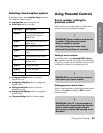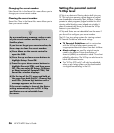
Finding Answers to Questions
Finding Answers to Questions 41
Finding Answers to Questions
Understanding TV Terms
What are analog TV, digital TV,
and high-definition (HDTV)?
Devices such as monitors, tuners, and integrated
monitor/tuner combinations are designed to handle
any of the 18 formats officially sanctioned by the
industry-led standard setting, Advanced Television
Systems Committee (ATSC), for the digital transmission
of video signals. There are three subgroups of digital
televisions depending on their capabilities:
High-definition (HDTV), enhanced-definition (EDTV),
and standard-definition (SDTV).
In contrast, U.S. analog television has been available
for over 50 years in the single National Television
Standards Committee (NTSC) format. This is the signal
that has been broadcast over the air and through
cable systems. NTSC television offers slightly more
than 480 interlaced lines of resolution.
What is the difference between
progressive and interlaced
signal formats for digital TVs?
There are 18 standard digital TV signal formats. Each
one provides a different picture quality. Digital TV
formats are named using a number followed by either
progressive (p) or interlaced (i). The letter refers to the
way the TV uses the signals to create the picture:
■ Progressive (p) scanning presents all the
horizontal lines of the picture in one frame. This
provides a sharper picture to the eye and looks
much better than an interlaced image of the same
resolution.
■ Interlaced (i) means that the picture appears in
two segments: every other horizontal line of the
picture is displayed in one frame, and the other
half of the horizontal lines are drawn in the next
frame of the picture. This works because it
happens so fast that the eye is deceived into
believing that only one picture is being shown.
The number refers to the number of lines of resolution,
and generally the higher the number, the better the
picture. For example, with digital TV (DTV) there are
two progressive formats for broadcasters to choose
from: 480p and 720p. A 480p image is much sharper
than a regular TV broadcast, although it is only
considered a DTV signal and not a true high-definition
signal. 720p has 720 horizontal scan lines and is
considered to be true HDTV. 720p can rival a 1080i
picture, which is 1,080 horizontal scan lines displayed
as an interlaced image. This is because of the sharper
and more accurate (progressive) 720p picture, even
though a 1080i picture has many more scan lines and
a much higher resolution.
What is variable aspect ratio?
The aspect ratio describes the relationship of screen
width to screen height. Standard TV signals are based
on the aspect ratio of 4:3 (four units wide by three
units high). HDTV signals are based on the aspect ratio
of 16:9, making the image 33 percent wider than a
normal TV and allowing viewing TV and movies as if
you were watching them in a theater.
In addition, many DVDs look better on the widescreen
display because most movies made in the last 50 years
were filmed in an aspect ratio of either 1.85:1
(very close to 16:9, which is equal to 1.78:1) or
2.35:1 (even wider than 16:9).
Variable aspect ratio support enables scaling of 4:3
and anamorphic video to fill the screen.


















